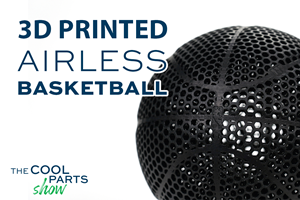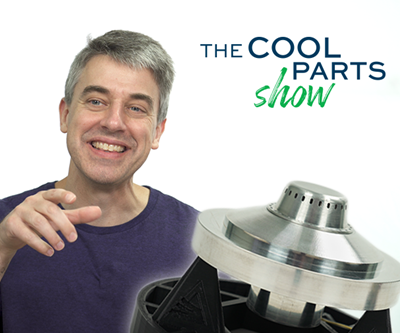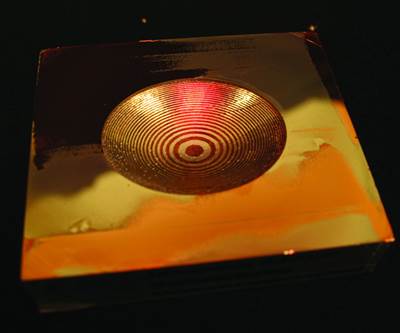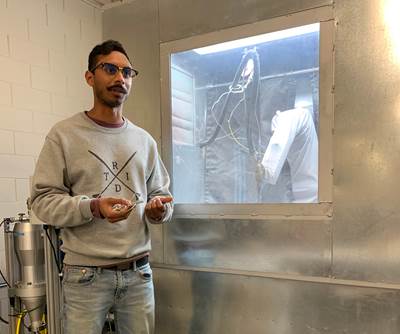Can 3D Printing Make a Better AM Build Plate?: The Cool Parts Show #5
Ultrasonic metal additive manufacturing was used to create a build plate aimed at making powder bed fusion more effective. This episode of The Cool Parts Show looks at a part by AM, for AM.
Share
Build failure resulting from thermal stress in the part is one of the perils of laser powder bed fusion metal additive manufacturing (AM). Build time might be lost on a part that has already broken free of its supports, and therefore is already doomed to be scrapped. But by using a different additive process, a form of sheet lamination called ultrasonic additive manufacturing, Fabrisonic developed a build plate with embedded sensing able catch the moment when the forces in the part change abruptly, suggesting a failure has occurred. Ultrasonic AM is a solid-state process (no melting), making it possible to install a fiber optic line midway through the build before resuming the build to finish the solid plate and seal the sensing line inside. The result is a build plate able to catch the precise moment something goes wrong.
This is our fifth episode of The Cool Parts Show, but our first to deal with a part that is strictly for 3D printing.
The Cool Parts Show is a video series from Additive Manufacturing Media that explores the what, how and why of unusual 3D printed parts. Watch more here.
Have a cool part to share? Email us.
Transcript
Peter Zelinski, Additive Manufacturing
An additive manufactured part helps make other additive manufactured parts. We get meta like that in this episode of The Cool Parts Show.
Peter Zelinski
I'm Pete.
Stephanie Hendrixson, Additive Manufacturing
I'm Stephanie.
Peter Zelinski
Welcome to The Cool Parts Show.
Stephanie Hendrixson
(musical interlude)
Peter Zelinski
Thanks again for watching The Cool Parts Show. I have a cool part made additively, where you have to be in additive manufacturing to appreciate the coolness of the part.
Stephanie Hendrixson
Pete, this looks like a build plate.
Peter Zelinski
It is a build plate, arguably the most boring component of the powder bed fusion metal additive process, but in powder bed fusion, what would you say is the biggest peril?
Stephanie Hendrixson
Probably build failure and not knowing that your build has failed until the very end.
Peter Zelinski
Yeah. So this build plate watches for build failure.
Stephanie Hendrixson
That's pretty cool. How does it do that?
Peter Zelinski
So this plate was made additively. A solid plate has a fiber optic sensor running all through it, capturing data in real time to monitor the build. This is additive manufacturing helping additive manufacturing.
Stephanie Hendrixson
So this plate was 3D printed with the fiber optic inside. How did they do that?
Peter Zelinski
Yeah. So it was not made through powder bed fusion. It's helping powder bed fusion. But it was made through a different process, a solid state additive process. This plate was made through ultrasonic additive manufacturing. No melting involved, no super high temperatures. This sensor cable was never in any danger. We talked about ultrasonic additive manufacturing in the very first episode of The Cool Parts Show. Here's a quick recap from Fabrisonic, which is the company that made this plate.
Mark Norfolk, Fabrisonic
So ultrasonic additive manufacturing is a type of 3D printing for metals. UAM is little bit different in that we're taking thin foils of metal on the order of five to ten thousandths of an inch and we're welding those together using ultrasound. The secret sauce there is we're not actually melting anything. This is all happening at room temperature. So what we do is we fold over the foil onto the material we want to bond and we roll over that with what we call an ultrasonic welder. As it rolls over, it's vibrating the sheet back and forth on the order of 20 thousand times a second. That vibration actually scrubs off any impurities, any oils, and most importantly, scrubs off the oxide layer. As soon as you have virgin metal touching virgin metal, Mother Nature takes over and you get a solid state bond.
Peter Zelinski
So ultrasonic additive manufacturing. This plate was built in layers, layers of metal foil bonded together. The build was paused halfway through. This fiber optic thread was snaked all through it all along the surface of the plate. And then the build resumed. Completely solid, one piece metal part with the sensor inside.
Stephanie Hendrixson
So you said this build plate can actually watch what's happening during the print. What is it watching for?
Peter Zelinski
Right. It is watching for stress, temperature and strain. This fiber optic sensor, it is threaded all along the area of the plate in different directions as it goes. It can measure strain along the direction of its length. So having it oriented in all different directions all along the plate lets it pick up different coordinate directions of the strain measurement. So strain can be measured as a vector. At pixel points in a grid all along the surface of this plate, that strain vector is being tracked while the build is happening. What it's really watching for are changes in those vectors, a sudden change in vector direction, a sudden change in the direction of strain at any one of those points. That's a sign something broke.
Stephanie Hendrixson
And so you can avoid those build failures by detecting the errors early.
Peter Zelinski
Yeah. And save yourself hours and hours of build time potentially just to make a scrap part. Once there's a build failure, you know it right away and you can start over.
Stephanie Hendrixson
This sounds really promising. Is this the final version of this build plate?
Peter Zelinski
Well, no. So here's more from Mark Norfolk, Fabrisonic. He has some ideas about where this could go next.
Mark Norfolk
Our initial try at a smart base plate, we kept all of our strain sensors in a single plane, which gives an amazing amount of data. We just recently were awarded a Phase 2 program where we're going to take this to the next level. And for us, the next level is actually to put in several different planes of data collection. By adding a second plane, one on top of the other, that's going to allow us to get data on moments or torque going through the plates, which will give us a whole other dimension of data that's just not available at this point.
Stephanie Hendrixson
All right. So to recap, this is a 3D printed build plate for powder bed fusion made with ultrasonic additive manufacturing. And that process allowed Fabrisonic to lay a fiber optic sensor all throughout, laid in different directions to track strain in different directions. It's also looking at stress and temperature and as a result of that, you can detect defects in the part before it's too late. You could stop the build right away, save lots of time, money, material.
Peter Zelinski
There you have it. Thank you for watching The Cool Parts Show. Tell us about your cool part. Maybe we do an episode on your part. We'd love that. CoolParts@AdditiveManufacturing.Media. Thank you for watching. Don't forget to subscribe.
Related Content
Airless Basketball Shows Promise of 3D Printed Lattices: The Cool Parts Show Bonus
Successfully matching the performance of a standard basketball demonstrates the control possible over the mechanical properties of digital materials.
Read More3D Printed Spacer Grids for Nuclear Power: The Cool Parts Show #79
Westinghouse Electric Company is exploring laser powder bed fusion as a means of manufacturing spacer grids, critical parts of the fuel rod assemblies used in pressurized water reactors.
Read MoreHow 3D Printing Aids Sustainability for Semiconductor Equipment: The Cool Parts Show Bonus
Hittech worked with its customer to replace fully machined semiconductor trays with trays made via DED by Norsk Titanium. The result is dramatic savings in tool consumption and material waste.
Read More3D Printed Cutting Tool for Large Transmission Part: The Cool Parts Show Bonus
A boring tool that was once 30 kg challenged the performance of the machining center using it. The replacement tool is 11.5 kg, and more efficient as well, thanks to generative design.
Read MoreRead Next
This Rocket Fuel Injector Is a Solid Part That Contains a Working Motor: The Cool Parts Show #1
Our new video series debuts with a look at a solid metal part made through additive manufacturing that was built with a motor embedded inside. The motor sealed within the part adjusts the rocket’s fuel mixture while the rocket is in flight.
Read MoreAM 101: What is Ultrasonic Additive Manufacturing?
Going from additive to subtractive can be simple with Ultrasonic Additive Manufacturing (UAM). What is it and how does it work? Learn the basics in this 101 post.
Read MoreIs Solid-State Additive Manufacturing an Enabler to the Internet of Things?
Startup Tri-D Dynamics sees precision cold spray 3D printing providing IoT-enabled parts with electronics built in. The promise is sensing in environments where the sensing might be needed most.
Read More















